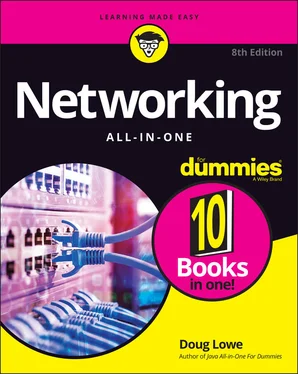19 Book 4 Chapter 4FIGURE 4-1: Network preferences.FIGURE 4-2: Advanced network settings.FIGURE 4-3: TCP/IP settings.FIGURE 4-4: DNS settings.FIGURE 4-5: Hardware settings.FIGURE 4-6: Users & Groups.FIGURE 4-7: Login Options.FIGURE 4-8: Joining a domain.FIGURE 4-9: Authenticating with the domain.FIGURE 4-10: Congratulations! You have now joined the domain.FIGURE 4-11: Welcome to the Finder.FIGURE 4-12: The Connect to Server dialog box.
20 Book 4 Chapter 5FIGURE 5-1: The Settings page.FIGURE 5-2: The Devices page.FIGURE 5-3: Pick a printer.FIGURE 5-4: Using a printer’s web interface.FIGURE 5-5: Changing network settings via a printer’s web interface.
21 Book 4 Chapter 6FIGURE 6-1: An IPSec configuration page on a Cisco ASA security appliance.FIGURE 6-2: A VPN client.
22 Book 5 Chapter 1FIGURE 1-1: Enabling Hyper-V on a desktop version of Windows.FIGURE 1-2: Hyper-V Manager.FIGURE 1-3: The Virtual Switch Manager window.FIGURE 1-4: Creating a new virtual switch.FIGURE 1-5: The New Virtual Hard Disk Wizard.FIGURE 1-6: Choose your disk format.FIGURE 1-7: Choose your disk type.FIGURE 1-8: Specify the name and location of the disk.FIGURE 1-9: Specify the size of the disk.FIGURE 1-10: Say hello to the New Virtual Machine Wizard.FIGURE 1-11: Specify the name and location of the virtual machine.FIGURE 1-12: Specify the generation of the new virtual machine.FIGURE 1-13: Specify the memory for the new virtual machine.FIGURE 1-14: Configure the networking for the new virtual machine.FIGURE 1-15: Connecting a virtual disk.FIGURE 1-16: The Installation Options page.FIGURE 1-17: Editing the settings for a virtual machine.FIGURE 1-18: Configuring a DVD drive.FIGURE 1-19: Viewing a virtual machine through a console.
23 Book 5 Chapter 2FIGURE 2-1: VMware Workstation Pro lets you experiment with virtualization.FIGURE 2-2: A virtual machine running Windows Server 2019.FIGURE 2-3: The first page of the New Virtual Machine Wizard.FIGURE 2-4: Selecting the operating system image file to install for the new vi...FIGURE 2-5: Selecting the Windows version and user account information.FIGURE 2-6: Naming the virtual machine.FIGURE 2-7: Specifying the virtual machine disk size.FIGURE 2-8: VMware is ready to create the virtual machine.FIGURE 2-9: Installing Windows Server 2019 on a virtual machine.FIGURE 2-10: Configuring virtual machine settings.FIGURE 2-11: Installing VMware Tools.FIGURE 2-12: The VMware Tools Setup program.
24 Book 5 Chapter 3FIGURE 3-1: The Azure Portal.FIGURE 3-2: The Azure Marketplace.FIGURE 3-3: Creating a virtual machine.FIGURE 3-4: The Disks tab.FIGURE 3-5: Creating a new disk.FIGURE 3-6: The Networking tab.FIGURE 3-7: Ready to create!FIGURE 3-8: Azure is deploying the VM.FIGURE 3-9: The deployment is complete!FIGURE 3-10: The Azure Dashboard.FIGURE 3-11: Managing a server from the Azure portal.FIGURE 3-12: Resizing an Azure virtual machine.FIGURE 3-13: The Connect page.FIGURE 3-14: Connecting to an Azure virtual machine.
25 Book 5 Chapter 4FIGURE 4-1: The AWS home page.FIGURE 4-2: The AWS Console.FIGURE 4-3: The Services menu.FIGURE 4-4: The EC2 Dashboard.FIGURE 4-5: Choosing a machine image.FIGURE 4-6: Choosing an instance type.FIGURE 4-7: Configuring instance details.FIGURE 4-8: Adding storage.FIGURE 4-9: Adding tags.FIGURE 4-10: Configuring the security group.FIGURE 4-11: Reviewing the instance settings.FIGURE 4-12: Creating a key pair.FIGURE 4-13: Your instances are being created!FIGURE 4-14: Managing EC2 instances.FIGURE 4-15: Connecting to an instance.FIGURE 4-16: Entering the path to the key pair file.FIGURE 4-17: AWS shows you the Administrator password.FIGURE 4-18: The console of an EC2 instance.
26 Book 5 Chapter 5FIGURE 5-1: Citrix Receiver.FIGURE 5-2: Connecting to a desktop.FIGURE 5-3: Viewing Excel on an iPhone.
27 Book 6 Chapter 1FIGURE 1-1: Welcome to Windows Setup!FIGURE 1-2: Selecting the OS edition to install.FIGURE 1-3: Setting the Administrator password.FIGURE 1-4: Press Ctrl+Alt+Del to log in.FIGURE 1-5: The Server Manager Dashboard.FIGURE 1-6: The Add Roles and Features Wizard.FIGURE 1-7: Selecting the server to manage.FIGURE 1-8: The Select Server Roles screen.FIGURE 1-9: The Select Features screen.
28 Book 6 Chapter 2FIGURE 2-1: Configuring remote access.FIGURE 2-2: Connecting with Remote Desktop Connection.FIGURE 2-3: A typical MMC window.FIGURE 2-4: An empty MMC console.FIGURE 2-5: The Add or Remove Snap-ins dialog box.
29 Book 6 Chapter 3FIGURE 3-1: Objects displayed by the Active Directory Manager console.FIGURE 3-2: Domains for a company with three departments.FIGURE 3-3: A forest with two trees.FIGURE 3-4: Creating a domain controller.FIGURE 3-5: The Active Directory Users and Computers console.FIGURE 3-6: Creating a new organizational unit.
30 Book 6 Chapter 4FIGURE 4-1: The Active Directory Users and Computers management console.FIGURE 4-2: Creating a new user.FIGURE 4-3: Setting the user’s password.FIGURE 4-4: Verifying the user account information.FIGURE 4-5: The General tab.FIGURE 4-6: The Account tab.FIGURE 4-7: Restricting the user’s logon hours.FIGURE 4-8: Restricting the user to certain computers.FIGURE 4-9: The Profile tab.FIGURE 4-10: Creating a new group.FIGURE 4-11: Adding members to a group.FIGURE 4-12: The User Profiles dialog box.
31 Book 6 Chapter 5FIGURE 5-1: Managing shares in Windows Server 2019.FIGURE 5-2: The New Share Wizard comes to life.FIGURE 5-3: The wizard asks where you’d like to locate the share.FIGURE 5-4: The wizard asks for the share name and description.FIGURE 5-5: Specifying the share settings.FIGURE 5-6: Setting the share permissions.FIGURE 5-7: Confirming your share settings.FIGURE 5-8: You’re done!FIGURE 5-9: Manually sharing a folder.FIGURE 5-10: Setting the share name.FIGURE 5-11: Setting the share permissions.FIGURE 5-12: The Select Users, Computers, Service Accounts, or Groups dialog bo...
32 Book 6 Chapter 6FIGURE 6-1: Enabling group policy management on Windows Server 2019.FIGURE 6-2: The Group Policy Management console.FIGURE 6-3: Creating a new group policy object.FIGURE 6-4: A new group policy object.FIGURE 6-5: Group policy settings.FIGURE 6-6: Editing group policy.FIGURE 6-7: The Windows Update policy settings.FIGURE 6-8: The Configure Automatic Updates dialog box.FIGURE 6-9: The Windows Update policy.FIGURE 6-10: Confirming the scope.FIGURE 6-11: The policy is finished.FIGURE 6-12: The IE Home Page Dummies policy.FIGURE 6-13: The Select User, Computer, or Group dialog box.FIGURE 6-14: A policy that uses a filter.
33 Book 6 Chapter 7FIGURE 7-1: The command prompt.FIGURE 7-2: An event generated by the EventCreatecommand.
34 Book 6 Chapter 8FIGURE 8-1: The PowerShell window.FIGURE 8-2: Online help for a PowerShell cmdlet.FIGURE 8-3: A PowerShell script.
35 Book 7 Chapter 1FIGURE 1-1: The available Office Enterprise plans.FIGURE 1-2: Enter an email address.FIGURE 1-3: Entering your personal information.FIGURE 1-4: Verifying your phone number.FIGURE 1-5: Entering the tenant name.FIGURE 1-6: Entering a user ID and password.FIGURE 1-7: Entering your credit card information.FIGURE 1-8: You did it!FIGURE 1-9: The Office 365 Admin Center.FIGURE 1-10: The Active Users page.FIGURE 1-11: Creating a new user.FIGURE 1-12: Assigning a product license.FIGURE 1-13: Applications included with the E3 license.FIGURE 1-14: Optional settings for the new user.FIGURE 1-15: Setting the new user’s roles.FIGURE 1-16: Setting the new user’s profile information.FIGURE 1-17: Are you ready to create the new user?FIGURE 1-18: The new user appears on the Active Users page.FIGURE 1-19: Displaying user information.FIGURE 1-20: Blocking a user’s access.
36 Book 7 Chapter 2FIGURE 2-1: The Office 365 home page.FIGURE 2-2: The Office 365 Admin Center.FIGURE 2-3: The traditional Exchange Admin Center.FIGURE 2-4: The new Exchange Admin Center.FIGURE 2-5: Adding a card to the new Exchange Admin Center.FIGURE 2-6: Managing mailboxes.FIGURE 2-7: The details pane for a user mailbox.FIGURE 2-8: Managing email addresses.FIGURE 2-9: Creating a new email address.FIGURE 2-10: Managing mailbox delegation.FIGURE 2-11: Granting permission.FIGURE 2-12: Selecting the user to which permission will be applied.FIGURE 2-13: This user will be granted Read and Manage permissions.FIGURE 2-14: Are you sure you want to convert this mailbox from regular to shar...FIGURE 2-15: Managing email appsFIGURE 2-16: Managing Mail Flow Settings.FIGURE 2-17: The Manage Email Forwarding pane.FIGURE 2-18: The email forwarder is all set up.FIGURE 2-19: Creating a Shared Mailbox.FIGURE 2-20: The shared mailbox has been created!FIGURE 2-21: Adding users to a shared mailbox.FIGURE 2-22: You now have a shared mailbox!
Читать дальше












